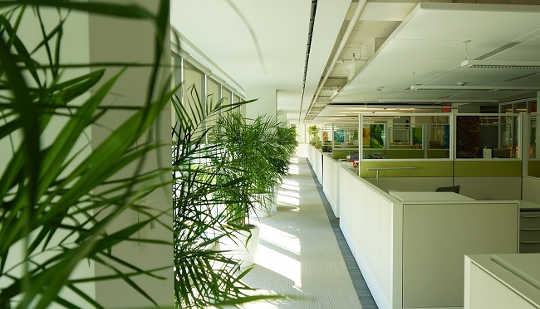
Research worldwide shows that environmentally-friendly buildings are much better for the health of the people who live and work in them, as well as for the Earth.
Buildings that are designed to cut water and energy use and make as little impact on the surrounding environment as possible make life much better for their occupants too.
Studies into 69,000 buildings − homes, offices and factories − in 150 countries show that there are fewer illnesses among residents and workers, who report they are more comfortable and happier. Employers also find they are more productive.
Companies that opt for “green” buildings gain because workers stay longer in their jobs and have fewer absences, while recruitment is easier because new employees are attracted to environmentally-friendly buildings.
Get The Latest By Email
Dr. Joseph Allen and fellow environmental health researchers at the Harvard TH Chan School of Public Health in the US studied reports from across the world into the effect of green buildings on the health of the occupants. Fifteen studies are incorporated into the review, published in the journal Current Environmental Health Reports.
Healthier Effects
There are now 3.5 billion square feet (0.325 sq metres) of certified green building space available worldwide, and researchers in many different countries have been measuring the effects to see if these buildings are also “ healthier” buildings.
“Overall, the initial scientific evidence indicates better indoor environmental quality in green buildings versus non-green buildings, with direct benefits to human health for occupants of those buildings,” Allen says.
Occupants of green buildings are in general more satisfied with the indoor air quality, their workspace, building cleanliness, and maintenance in general, he adds.
The information is important for future building design because modern humans spend 90% of their time indoors.
The research measured internal air quality, light, noise and the presence of chemicals that might adversely affect health, as well as asking the people who live and work in them about their experience.
The information is important for future building design because, as the researchers point out, modern humans spend 90% of their time indoors.
To gauge the effect on health and well-being, the scientists looked at many studies that had taken into account factors that influence health − including radiological, chemical, biological and physical aspects of indoor environmental hazards.
Air Quality
They looked at air quality, ventilation, filtration, lighting and acoustics, and studied the architecture, the quality of the canteens, access to natural light, and the building’s surroundings.
In residential buildings, there were fewer asthma and other respiratory illnesses among children, and across all green buildings there fewer cases of sick building syndrome symptoms, with better physical and mental health all round.
The one area that did not score better was acoustics, with several studies reporting lower satisfaction about noise levels.
Where hospitals had been constructed as green buildings, the researchers found a better quality of care for patients. In one study, there were 70% fewer blood stream infections, improved record keeping, and overall patient mortality fell by 11% − although the scientists were unable to pinpoint what factors produced such a startling improvement. – Climate News Network
About the Author
 Paul Brown is the joint editor of Climate News Network. He is a former environment correspondent for The Guardian newspaper and teaches journalism in developing countries. He has written 10 books − eight on environmental subjects, including four for children − and written scripts for television documentaries. He can be reached at [email protected]
Paul Brown is the joint editor of Climate News Network. He is a former environment correspondent for The Guardian newspaper and teaches journalism in developing countries. He has written 10 books − eight on environmental subjects, including four for children − and written scripts for television documentaries. He can be reached at [email protected]
 Book by this Author:
Book by this Author:
Global Warning: The Last Chance for Change
by Paul Brown.
Click here for more info and/or to order this book on Amazon.








